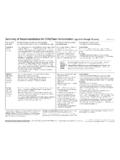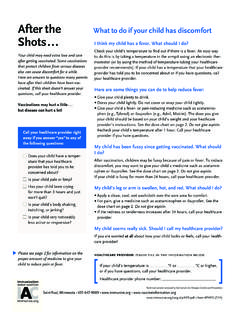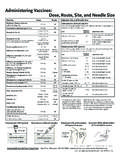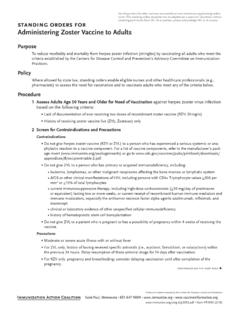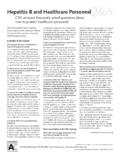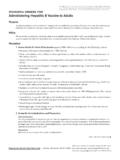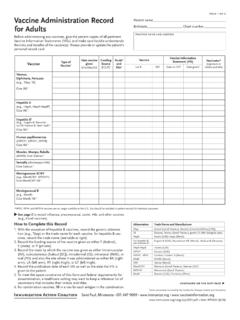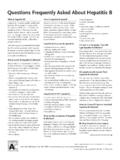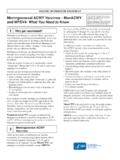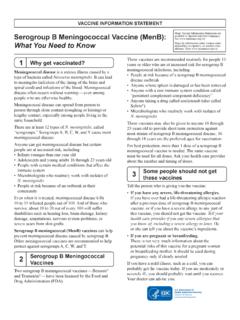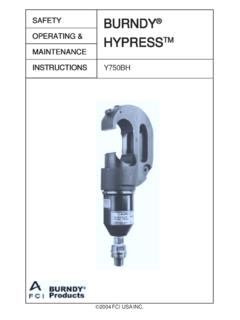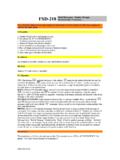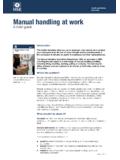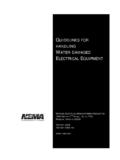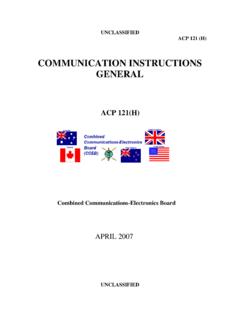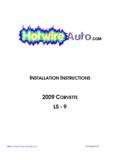Transcription of Checklist for Safe Vaccine Storage and Handling
1 Checklist for Safe Vaccine Storage and Handling Are you doing everything you should to safeguard your Vaccine supply? Review this list to see where you might make improvements in your Vaccine management practices. Check each listed item with either yes or no . Establish Storage and Handling Policies yes no 1. We have designated a primary Vaccine coordinator and at least one alternate coordinator to be in charge of Vaccine Storage and Handling at our facility. yes no 2. Both the primary and alternate Vaccine coordinator(s) have completely reviewed either CDC's Vaccine Storage & Handling Toolkit ( pdf) or equivalent training materials offered by our state or local health department's immunization program.
2 Yes no 3. We have detailed, up-to-date, written standard operating procedures for general Vaccine management, including procedures for routine activities and an emergency Vaccine retrieval and Storage plan for power outages and other problems. Our procedures are based on CDC's Vaccine Storage & Handling Toolkit and/or on instruction from our state or local health department's immunization program. yes no 4. We review these policies with all staff annually and with new staff, including temporary staff, when they are hired. Log In New Vaccine Shipments 5. We maintain a Vaccine inventory log that we use to document the following: yes no a.
3 Vaccine name and number of doses received yes no b. Date we received the Vaccine yes no c. Condition of Vaccine when we received it yes no d. Vaccine manufacturer and lot number yes no e. Vaccine expiration date Use Proper Storage Equipment yes no 6.. We store vaccines in separate, self-contained units that refrigerate or freeze only. If we must use a house- hold-style combination unit, we use it only for Storage of our refrigerated vaccines, maintaining frozen vaccines in a separate stand-alone freezer. yes no 7.. We store vaccines in units with enough room to maintain the year's largest inventory without crowding.
4 Yes no 8. We never store any vaccines in a dormitory-style unit (a small combination freezer-refrigerator unit with the freezer compartment inside the refrigerator). yes no 9.. We use only calibrated thermometers that have a Certificate of Calibration Testing* ( Report of Calibra- tion ) and are calibrated every 1 to 2 years from the last calibration testing date or according to the manufacturer's suggested timeline. yes no 10. We have planned back-up Storage unit(s) in the event of a power failure or other unforeseen event. continued on the next page . * Certificate of Calibration Testing ( Report of Calibration ) with calibration measurements traceable to a laboratory with accreditation from the International Laboratory Accreditation Cooperations (ILAC) Mutual Recognition Arrangement (MRA) signatory body.
5 Technical content reviewed by the Centers for Disease Control and Prevention Saint Paul, Minnesota 651- 647- 9009 Item #P3035 (11/16). Checklist for Safe Vaccine Storage and Handling (continued) page 2 of 3. Ensure Optimal Operation of Storage Units yes no 11. We have a Do Not Unplug sign ( , ) next to the electrical outlets for the refrigerator and freezer and a Do Not Stop Power warning label ( , ) by the circuit breaker for the electrical outlets. Both signs include emergency contact information. yes no 12.. We perform regular maintenance on our Vaccine Storage units to assure optimal functioning.
6 For example, we keep the units clean, dusting the coils and cleaning beneath the units as recommended by the manufacturer. Maintain Correct Temperatures yes no 13. We always keep at least one accurate calibrated thermometer (+ C [+/-1 F]) with the vaccines in the refrigerator and a separate calibrated thermometer with the vaccines in the freezer. 14. We use a thermometer that yes no a. uses an active display to provide continuous monitoring information. yes no b. is digital and has a detachable probe that has been buffered against sudden temperature changes by being immersed in a vial filled with liquid ( , glycol, ethanol, glycerin), loose media ( , sand, glass beads), or a solid block of material ( , aluminum, Teflon ).
7 Yes no c. includes an alarm for out-of-range temperatures. yes no d. has a digital data logger that indicates current, minimum, and maximum tempreratures. yes no e. can measure temperatures within + C (+/-1 F). yes no f. has a low-battery indicator. yes no 15. We maintain the refrigerator temperature at 2 8 C (36 46 F), and we aim for 5 C (40 F). yes no 16.. We maintain the freezer temperature between -50 C and -15 C (-58 F and +5 F). yes no 17. We set the thermostat for the refrigerator and the freezer at the factory-set or midpoint temperatures. yes no 18. We keep extra containers of water in the refrigerator ( , in the door and/or on the floor of the unit where the vegetable bins were located) to help maintain cool temperatures.
8 We keep ice packs, ice-filled containers, or frozen water bottles in the freezer to help maintain cold temperatures and to have frozen water bottles available for conditioning in the event of an emergency. Maintain Daily Temperature Logs yes no 19. On days when our practice is open, we visually inspect the Vaccine Storage unit twice a day (first thing in the morning and right before our facility closes) and document refrigerator and freezer temperatures on the appropriate log. (See selections at ). yes no 20. We document the minimum and maximum temperature readings in the refrigerator and freezer once each day, preferably in the morning.
9 Yes no 21.. We consistently record temperatures on the log either in Fahrenheit or Celsius. We never mix temperature scales when we record our temperatures. yes no 22. If the temperature log prompts us to insert an x by the temperature that's preprinted on the form, we do not attempt to write in the actual temperature. yes no 23. We follow the directions on the temperature log to call appropriate personnel if the temperature in a Storage unit goes out of range. yes no 24. If out-of-range temperatures occur in the unit, we complete the Vaccine Storage Troubleshooting Record ( ) to document actions taken when the problem was discovered and what was done to prevent a recurrence of the problem.
10 Continued on the next page . Immunization Action Coalition Saint Paul, Minnesota 651- 647- 9009 Item #P3035 (11/16). Checklist for Safe Vaccine Storage and Handling (continued) page 3 of 3. yes no 25.. Trained staff (other than staff designated to record the temperatures) review the temperature logs weekly. yes no 26. We keep the temperature logs on file for at least 3 years. Store Vaccines Correctly yes no 27. We post signs ( , ) on the doors of the refrigerator and freezer that indicate which vaccines should be stored in the refrigerator and which in the freezer. yes no 28. We do not store any food or drink in any Vaccine Storage unit.
